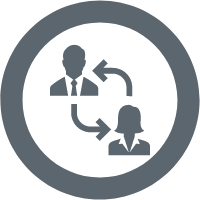Supportive HR Policies Organizational
Description
To truly develop the frontline workforce, you need more than programs or initiatives designed for them. Good HR policies are a competitive advantage, as they can expand talent pipelines and improve employee engagement and retention. Policies should facilitate access to existing jobs and opportunity for advancement, not create unintentional roadblocks. Supportive HR policies take into account the lived experiences of their entry level workers and are designed with them in mind. Policies that facilitate career advancement should align with the recruitment process and demonstrate transparency around career pathways.
Process
As you advance investments in the frontline workforce, regularly evaluate current human resources policies and practices to ensure they truly support professional development and career advancement for these workers.
- Do your research. When it comes to HR policies, what is common practice may not always be best practice. Look to organizations with high rates of employee satisfaction to identify and assess opportunities for improvement. Gather data to demonstrate how policy changes can positively impact business priorities and create a competitive advantage.
- Avoid unintended consequences. Even as you operate with the best intentions, think about how human resources policies and practices will impact the people they’re designed to help. Could a raise of $1 an hour make an employee ineligible for public benefits? Does the upfront cost required for tuition reimbursement prevent lower wage employees from accessing this benefit? Gather input directly from workers to reveal potential blind spots.
- Adopt a P-T-R strategy. PTR[1], which stands for preference, tradition, and requirement, is a decision-making strategy to incorporate more diverse and inclusive practices. It encourages leaders to consider whether a policy is in place simply because “it’s always been like that.” It helps to differentiate between preferences and requirements. For example, a longstanding and recycled job description may list minimum requirements that aren’t actually indicators of job success or competency—but do unnecessarily limit the applicant pool.
What do supportive policies look like? Supportive policies acknowledge the lived experience of frontline workers and address barriers they may face in getting and keeping a job.
| Instead of (Traditional Policy) | Try (Supportive Policy) |
| Learning opportunities are limited to standard work hours | Multiple learning options and methods, such as work-based learning and flexible learning options |
| Onboarding that focuses on completing administrative requirements | Structured onboarding that sets clear expectations, orients new staff to workplace culture, and provides supportive resources |
| Tuition reimbursement that requires staff to pay for tuition and materials upfront | Tuition assistance that pays for tuition, fees, and textbook costs in advance or through deferred billing |
| Punitive responses to tardiness or absenteeism | Supervisory training to build coaching skills and help employees troubleshoot challenges to getting to work |
| High school diploma or post-secondary degree requirements that don’t reflect a position’s needed skill set | Qualification requirements that reflect job competencies |
| Restrictive policies that limit opportunities to people who have been incarcerated or have a criminal record. | A policy that does not ask applicants to disclose a criminal history on the initial application and performs individual assessments later in the hiring process. |
[1] Here’s EY’s Simple but Effective Strategy for Increasing Diversity, Fortune.com, February 10, 2017.
CareerSTAT Members Implementing This Practice
Resources
Job Design Framework, National Fund for Workforce Solutions
The Job Design Framework offers a menu of components that come together in different ways to create the right quality job for the context.
Cincinnati Women’s Foundation Employer Toolkit, Women’s Fund of Greater Cincinnati Foundation, May 2018.
A toolkit filled with actionable policies and practices to benefit frontline workers and business bottom line.
Guide to Employee Financial Wellness, National Fund for Workforce Solutions, May 2020.
A step-by-step guide to find out what financial wellness solutions can do for your organization.
Key Elements of Successful Tuition Assistance Program – Institute for Corporate Productivity (i4cp) and UpSkill America, October 2018.
An outline of adaptable best practices for tuition assistance programs.
Advancing your Frontline Workforce with Employer-Sponsored Education Benefits, GED Testing Service, March 2017.
A white paper on best practices for education benefit programs.
A Healthcare Employer Guide to Hiring People with Arrest and Conviction Records, National Employment Law Center, September 2016.
A toolkit with guidance to implement a hiring program for people with records.
Leading Practices for Hiring Returning Citizens A Returning Citizens Working Group Report, Talent 2025, September 2017.
A report to educate West Michigan employers on the benefits of hiring from this population, address misconceptions, and provide effective and best practice hiring strategies.
Guide to Investing in Frontline Health Care Workers, CareerSTAT, National Fund for Workforce Solutions, 2017.
A guide that provides strategies and a framework for investing in the skills and careers of frontline worker to increase business impact and provide workers with opportunities for advancement and growth.
Related Best Practices
Provide Structured Onboarding of New Hires
PROGRAMMATIC | The transition to a new job is often challenging, especially for workers moving from unemployment or a non-clinical environment.
Read MoreCareer Exploration Tools and Opportunities
PROGRAMMATIC | Job seekers and people in entry-level jobs may have had little opportunity to consider how to build a career.
Read MoreWork-Based Learning
PROGRAMMATIC | Work-based learning is an educational strategy combines classroom and real-life work experiences.
Read MoreCareer Pathways
PROGRAMMATIC | Healthcare provides one of the greatest opportunities for jobs in today’s economy. However, many people do not know about the array of healthcare jobs that exist and struggle to see how an entry level job can grow into a career.
Read MoreCareer Coaching
PROGRAMMATIC | One of the advantages to working in healthcare is that offers multiple career paths that lead to jobs paying family-sustaining wages.
Read MoreBasic Skill Development
PROGRAMMATIC | Entry-level employees don’t always have the reading, math, technology, or English language skills to excel in their current position or advance their career.
Read More
